Happy 100th birthday—now shhh!
September 6, 2012
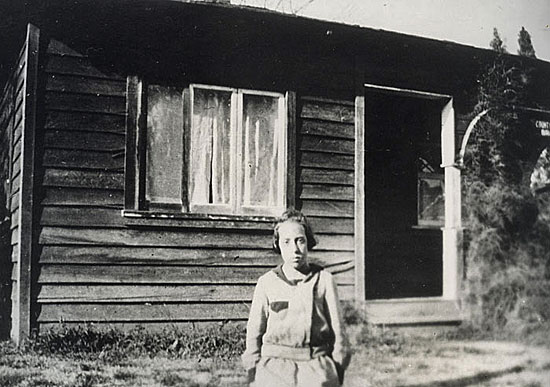
The first branch of the L.A.County library opened in 1913 in the Willowbrook home of Belle Jenks, seen here.
Party in the stacks! The County of Los Angeles Public Library is celebrating its 100th birthday this week, with tributes that range from flash mobs to free cupcakes.
“Every one of our libraries will have its own party on Saturday,” County Librarian Margaret Donnellan Todd says. “There will be a huge variety of things—performances, story times, birthday cards, book giveaways.”
The library is asking readers to help compile a list of the 100 all-time favorite books in L.A. County, and has posted a “100 Things Challenge” in honor of the milestone anniversary.
Contestants already have posted photos of 100-item compilations both light (ducks, fingers, pennies) and literary (books, stamps, bookmarks). Meanwhile, a group of teenagers has put out a call for a flash mob to do a “Call Me Maybe” parody video at the El Monte branch library.
Born of a state law passed to bring libraries to the then-sparsely-populated parts of California, the county library has grown through the decades to become one of the largest library systems in the nation. Its 85 branches and 7 million-plus books and other items serve 3.5 million county residents.
It opened on Sept. 5, 1912, in a small room on the 10th floor of the downtown Hall of Records. Less than a year later, it had its first branch—a 50-volume collection in a house in Willowbrook. The homeowner, Mrs. Belle Jenks, would later report that, within the first two months, she had registered 63 borrowers and collected 60 cents in overdue book fines. She went on to serve as a community librarian for more than three decades.
The library went on, too, surviving earthquakes, wars, riots, Y2K and the Great Depression. (You can read all about it on the library’s centennial list of 100 historical factoids.)
The library branches served as civil defense centers during World War II and stocked up on “how-to” books for returning job seekers after the war ended. It expanded into isolated rural areas in the 1940s and ‘50s with bookmobiles in the Antelope Valley, and reached out to isolated urban readers in 2000 with bookmobiles in low-income parts of Los Angeles.
In the politically active 1970s, the library opened Chicano, Asian Pacific, American Indian and African-American resource centers. And as immigrants flocked to Los Angeles in the 1980s, it launched language learning centers. In the 1990s, the library expanded service via the Internet. Today, book and music downloads are among its most popular offerings. There’s even a county library cell phone app.
Library lovers can click here to find the nearest centennial events, which will run throughout the week.
“It’s kind of amazing to think that we’ve been such a part of Los Angeles for so long,” Todd says, “but our basic mission hasn’t really changed. We’re still here to provide literacy and learning and culture to everyone in Los Angeles County, for free.”
Posted 9/6/12
High season for rescues
July 25, 2012
For the Malibu Search and Rescue team, things can get crazy-busy out there.
Emphasis on the crazy. Inspired by videos posted online, hikers are flocking to spots like Rindge Dam in Malibu Canyon, where the inexperienced, unlucky or foolhardy can get into trouble fast.
A dramatic, 7-hour rescue operation last week—in which three lost and stranded hikers who’d apparently learned of the spot in an Internet video had to be pulled out of a deep canyon in the darkness—illustrates what can happen when YouTube-fueled aspirations run into the rugged realities of the great outdoors.
Other factors attracting crowds to local wilderness areas include good weather, the opening of new trails and facilities in the Santa Monica Mountains, the popularity of online “meetups” for hikers and even a trend toward stay-at-home vacations.
In Malibu, that adds up to what may be the busiest season yet for the local rescue team, made up of about 30 reserve sheriff’s deputies and civilian volunteer specialists and support staff.
Coming off last year’s record-setting 128 call-outs, the team as of last week had logged 75 responses in 2012, compared to 68 at this time last year. “And we haven’t gotten into August yet,” said Jeremy Littman, a television writer who keeps the stats for the team and serves as its lieutenant.
Two people have died, one of them a suicide, at Rindge Dam in the past eight or nine months, said David Katz, another member of the team who also acts as its public information officer. Others have been injured jumping off the dam into the water below—a stunt immortalized in YouTube videos, some of them set to music.
“It’s a dam. It’s not built for playtime,” Katz said. “It’s a dangerous area and if you do get injured and have to be evacuated, you’re 600 feet deep in a canyon.”
The surge in rescue calls isn’t limited to Malibu. Through June, calls were up year-over-year for all but one of the county’s eight search and rescue teams.
“It sure has been an active few months across the county,” said Michael Leum, assistant director of the sheriff’s Reserve Forces Bureau and reserve chief of its search and rescue operations countywide. “It’s been super-busy, with people staying around locally and doing the ‘staycation’ thing. On Sunday alone, Crescenta Valley had 10 different response calls.”
And Friday, July 13, proved to be a particularly unlucky day for hikers in Eaton Canyon—and an exceptionally demanding one for rescuers, who had to make three helicopter rescues within the space of an hour.
In Leum’s view, one of the risk factors for getting in trouble on the trail is simply being male.
“Ninety-nine percent of the people we go looking for are guys who go out by themselves and don’t tell anyone where they’re going,” Leum said.
Added Sgt. Tui Wright of the Malibu/Lost Hills Sheriff’s Station, who oversees the area’s search and rescue team: “There really is a lack of common sense out there and people do a lot of things to put themselves in peril.”
Still, you don’t have to be a thrill-seeker to run into trouble, said Malibu search and rescue team captain Mark Campbell. “Some things do happen to well-meaning people,” he said. Those who want to stay out of harm’s way should file a hiking plan with the sheriff’s department before setting out. (Download one here.) Other tips: allow plenty of time to complete the hike before dark; carry water, food and warm clothes; pay attention to the weather forecast; and bring along a well-charged cell phone.
Carrying a phone is particularly important. Because while technology leads some people into trouble, it also can help lead them out of it—sometimes in unexpected ways.
Consider the case of the 17-year-old hiker, stranded last month on a steep ridgeline, who used the light from his iPhone to help rescuers find him and whisk him to safety.
Posted 7/25/12
The Malibu search and rescue team is looking for volunteers. Details on how to join are here.
Ex-jail captain feeling the heat
July 12, 2012

Inside Men's Central Jail, where allegations of brutality led to the creation of a commission on jail violence.
Eight months ago, amid mounting reports of brutality in Los Angeles County’s jails, Sheriff Lee Baca would offer only a few words of explanation about why the former captain of the Men’s Central Jail had been placed on leave and sent home.
“I’m looking into a few matters,” the sheriff said.
In recent weeks, some of those matters have come into very public view.
Captain Daniel Cruz has unhappily found himself front-and-center in an investigation by the Citizens’ Commission on Jail Violence, a high-powered panel created by the Board of Supervisors to, among other things, “restore public confidence in the constitutional operation of our jails.”
During the commission’s last two hearings, Cruz has been accused by former and current members of the department of failing to hold deputies accountable for significant levels of serious force against inmates. According to testimony, scores of brutality investigations languished over the years in file boxes and desk drawers, undermining the department’s ability to track abusive deputies. One witness, a former lieutenant, said he was repeatedly told by Cruz not to spend too much time attacking the backlog that had been growing under the captain and his predecessors.
In an interview, Cruz insisted that he’s undeservedly being vilified for reasons that have more to do with personalities than with facts.
“I’m in front of the firing squad right now and everybody is taking a shot at me,” the 33-year department veteran told a writer for Supervisor Zev Yaroslavsky’s website. “I have to sit back and listen to everybody saying what a schmuck I am. If I was reading what’s in the papers, I would think this guy wasn’t doing his job. But that’s far from the case. It’s not a true representation of my character. I worked very hard to reduce force at CJ [Central Jail] and the numbers show that I did.”
Cruz served as the Men’s Central Jail captain between 2008 and 2010. He was transferred to the department’s Transit Services operation before being placed on paid leave. So far, he has not appeared before the 7-member commission, whose members include retired judges, the current Long Beach police chief and the one-time spiritual leader of First AME Church. But Cruz said he wants to share his side of the story with investigators. “I’d like to get my turn at bat,” he said.
Also emerging as a central figure in the commission’s inquiry has been the man who reportedly favored Cruz for the job, Undersheriff Paul Tanaka. He, too, has been criticized in testimony for allegedly creating a culture that fostered excessive force by openly deriding the work of internal affairs investigators and by ordering supervisors to, among other things, “coddle” jail deputies.
For his part, Tanaka, the department’s No. 2 man and the mayor of Gardena, has so far remained quiet, declining requests for comment. He and Baca are scheduled to testify before the commission on July 27, a hearing that’s certain to generate considerable interest within a department that has been rocked by the ongoing controversy over its management of the county’s vast jail system.
By all accounts, conditions have improved markedly in the jail as Baca has moved to intensify oversight and accountability. He has installed new leadership there and created a commander-level task force that briefs him regularly on jail operations and trends. Incidents of significant force have fallen dramatically.
Still, the commission was given a mandate by the Board of Supervisors to look back at the possible root causes of the problems that led to the panel’s creation last October and offer recommendations for the future. Along the way, it has generated a number of disclosures about the policies and people who have governed jail operations.
Beginning during a commission hearing in mid-May, it became evident that panel investigators—many of them former federal prosecutors working pro bono—had begun to believe that specific individuals may have been as responsible for a rise in serious inmate injuries as any structural or systemic problems. During that session, both Cruz and Tanaka were criticized by two retired officials of the jail for allegedly undermining efforts to break-up deputy cliques and of failing to hold jailers accountable for unnecessary force.
That theme continued last week with testimony from an active-duty captain, Michael Bornman, a 30-year veteran who currently oversees educational programs in the jail. Obviously uncomfortable as he was questioned by the commission’s executive director, Bornman described his testimony as “the hardest thing I’ve ever done in my entire life.” Commission staff say he was encouraged to appear before the panel by Baca himself.
Bornman recalled instances that he said raised alarms in his mind about Cruz’s views on deputy violence—both on and off the job. One of those incidents involved the beating by several deputies of an inmate near a jail medical clinic, which was captured on a newly installed video camera about which few knew. According to Bornman, the prisoner was punched, kicked and repeatedly knee-dropped by one particularly bulky deputy. The inmate, he said, suffered broken ribs.
If that wasn’t disturbing enough, Bornman said, he was taken aback by what he contended was Cruz’s reaction. “I see nothing wrong with that use of force,” Bornman quoted the captain as telling a group of jail supervisors, who’d gathered to watch the video. Ultimately, an internal investigation—with Bornman’s active participation—called for the firing of one deputy and the suspension of two others.
Bornman also recounted a speech he said Cruz gave in 2009 to a banquet hall filled with jail deputies during their annual holiday party. “What do I always tell you guys?” Cruz reportedly asked the crowd. “Not in the face!” they responded in unison—an allusion, Bornman said, to how to strike an inmate without leaving tell-tale marks.
But Cruz, in the interview, disputed Bornman’s account, saying that his former subordinate offered a sinister and incomplete version of the event.
Cruz said he typically ended his remarks to the troops with three admonitions: “Don’t drive drunk. Don’t put your hands on your wives and girlfriends and don’t hit people in the face.” Cruz said that last warning had nothing to do with hiding the signs of a beating. “When you hit someone in the face, you can end up injuring yourself and the inmate,” he said. “It’s generally an ineffective tactic.”
Whatever the case, Bornman said he was so put off that he decided to sit out the following year’s ill-fated party at the Quiet Cannon in Montebello, where deputies from different floors of the Men’s Central Jail squared off in a wild parking lot brawl. When Montebello police arrived, Cruz assured them there was nothing left to investigate, that all was resolved. In the end, six deputies were ordered fired.
Said Bornman: “I could have predicted what happened there.”
As in the commission’s May hearing, panel members explored the relationship between Cruz and Tanaka. Under questioning from one commission member, former U.S. District Judge Robert Bonner, Bornman said Cruz “made it very clear that Mr. Tanaka had helped him.” In fact, Bornman quoted a defiant Cruz as insisting that he still reported to Tanaka, who was no longer even in charge of custody operations.
Although Tanaka is largely unknown to the public, he is powerful presence within the Sheriff’s Department, second in command to the elected Baca. He receives high marks from many in the department. But he’s been criticized during the commission’s hearings, which have dealt only with a limited part of his broad portfolio. Among other things, he’s been called to task for allegedly brushing back supervisors in the jail and elsewhere when they’ve tried to rein in deputies they believe are acting too aggressively.
On Friday, for example, the commission released a 2007 memo that memorialized a visit by then-Assistant Sheriff Tanaka to the Century Station, an area of high gang activity. The memo was written by the station’s captain at the request of the region’s field operations commander. In it, the captain quotes Tanaka as warning captains and supervisors not to be “hasty” in filing complaints, or “cases,” against aggressive deputies, “who should function right on the edge of the line.” Tanaka said such actions can have “a negative impact on his performance and personal life.”
The memo went on say that Tanaka does not like the Internal Affairs Bureau and then recounted this promise from the assistant sheriff: “He said he would be checking to see which Captains were putting the most cases on deputies and that he would be putting a case on them.”
Posted 7/12/12
County braces for a wave of L.A. ink
May 24, 2012
Since 1998, Roger “Rabb!t” Rodriguez has been a professional body artist. Piercing, tattooing, branding—he’s seen it all. But in all his time in Greater Los Angeles, in studios from West Hollywood to Pasadena, there’s one thing he has yet to encounter: A health inspection.
That’s about to change this summer.
Starting July 1, California counties will begin enforcing comprehensive state standards for tattooing, body piercing and permanent cosmetics. The Safe Body Art Act, passed in October, is expected to finally bring some uniformity to a municipal patchwork that for decades has hindered widespread regulation of the burgeoning body art industry.
Public health officials applaud the measure, as do most established artists because unsafe practices in piercing and tattooing can lead to HIV and hepatitis. But the new law also promises to dramatically ramp up enforcement, and at the Department of Public Health, the county’s tiny Body Art Unit is braced for big changes.
“This is probably going to quadruple our workload,” says Cole Landowski, head of the county’s environmental hygiene program.
Once a sign of rebellion, tattoos and piercings have increasingly become mainstream, adorning bodies of all ages. Celebrities have taken the industry upscale, and even reality TV has gotten into the act, chronicling the exploits of high profile artists such Los Angeles’ Kat Von D.
Oversight has struggled to keep pace, however. Until this year, California law mandated only that body art businesses register with their respective counties and receive a copy of sterilization and sanitation guidelines.
Counties were free to impose ordinances that went further, but most didn’t. Riverside County, for instance, didn’t regulate body artists until last year, after its lack of enforcement was taken up by a grand jury. Meanwhile, efforts to legislate minimum statewide standards repeatedly failed amid arguments that such regulation would drive away businesses.
Assemblywoman Fiona Ma (D-San Francisco), who helped push through the new law, noted after it passed that manicurists “need 400 hours of training before they can cut your nails, yet until [now], tattooists and piercers have had no training requirements to stick a needle in you.”
Los Angeles County was, for many years, one of the few to regulate piercing and tattoo parlors. “We’ve recognized this as a public health issue for a long time,” says Terri Williams, assistant director of the Environmental Health Division of the Department of Public Health.
The county passed an ordinance in 1999 requiring practitioners to not only register, but also obtain a county health permit and receive blood-borne pathogen training. Facility owners also had to obtain health permits and adhere to standards of design, maintenance and sanitation.
But the county ordinance only extended to unincorporated areas and the 14 smaller cities that opted into the county requirements. The rest of the county’s 88 cities, including the City of Los Angeles, had little, if any regulation beyond business licenses and zoning restrictions.
“I’ve been doing this for 14 years professionally and at no time do I ever recall being inspected,” says Rodriguez, a nationally known piercing artist whose current shop, Ancient Adornments, is a West Hollywood fixture.
Rodriguez’ various workplaces were outside the county’s jurisdiction, but even within it, enforcement was a challenge. At last count, some 480 facilities were licensed in the unincorporated county and contract cities, Williams says, and those are just the ones operating in the open. Rodriguez and others note that many more body artists work underground, setting up un-permitted shop in homes and barrooms.
The three environmental hygienists doing body art regulation must squeeze between 10 and 25 inspections a month into their other duties, which range from noise and odor complaints to asbestos and mold inspections.
“Our hands are pretty full—actually, they’re really full, ” says Francis Pierce, who does most of the county’s body art inspections. (For the record, Pierce has no tattoos or piercings, although he jokes that “several hundred people have offered to do it, for free, even, but what can I say? I’m 53 years old and I have no tats.”)
Now comes the new law, which will require body artists from throughout the county not only to obtain health permits by July 1, but also to renew them annually instead of every three years.
County public health officials know they’ve got a huge challenge ahead of them, given the size of the Body Art Unit and the mounting numbers of establishments that will require inspections. The unit will be responsible for every city except Pasadena, Long Beach and Vernon, which have their own health departments. That means the unit could see its caseload quadruple to as many as 2,000 establishments covered by the new law.
“We suspect that we’ve just been hitting the tip of the iceberg, as it is,” says Landowski. “Who knows what we’re going to run into in the cities? Some of those parlors in Hollywood are the size of postage stamps. Then there’s Venice. . .”
Still, Williams says she’s confident her squad, which she expects to grow by five staffers, can handle the job. Already, the department has been assembling a database, putting together registration packets for establishments and artists, hosting training sessions and doing outreach.
“We’re going to do this well, and be organized in what we do,” she says. Admittedly, it will take time (“They may not all show up saying, ‘Yoo-hoo! We’re here for our health inspection!’”), and everything might not get done before July 1.
But, she says, “we’re looking forward to a positive working relationship. In my experience, it’s a very cooperative industry.”
Rodriguez, the body artist, says he welcomes the scrutiny.
As a member of professional organizations and a former emergency medical technician, he has made scrupulous sanitation his hallmark, but resents being undercut by competitors who endanger the public with careless work and subpar jewelry.
“A lot of artists have no clue,” he says. “They’re just Joe Schmoe, working at a tattoo shop. Putting the public first—that’s what the benefit of this law is going to be.”
Posted 5/24/12
Bug fare at the Bug Fair
May 16, 2012
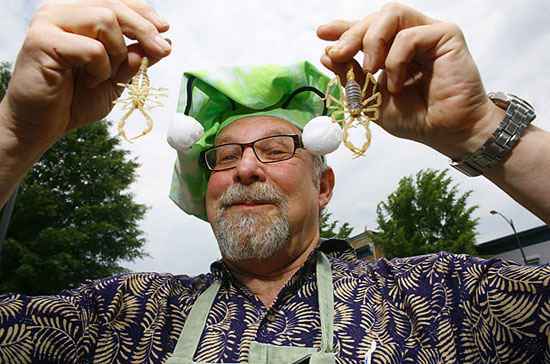
David George Gordon, who won last year's bug cookoff, is an ardent advocate of insect cuisine. Photo/Time
Fancy yourself an adventurous eater? The county’s Natural History Museum has something to challenge your palate at the 26th annual Bug Fair. That’s right—it’s time to grub on grubs.
The “Bug Chef Cook-Off” debuted at last year’s fair, and it’s back again in 2012 by popular demand. Three of the top entomophagists (bug chefs) from across the country are ready to go antenna to antenna with their best bug dishes.
They’re part of a burgeoning bug cuisine movement that’s grabbed the attention of publications including Time and The New Yorker, which have chronicled the efforts of those seeking to make insects palatable as human food for a variety of environmental, ethical and economic reasons.
One of the movement’s stars, David George Gordon, won last year’s cook-off at the museum with tempura-battered tarantula and teriyaki grasshoppers on rice noodles. Gordon, 62, an ardent bug consumption advocate, said hosting the cook-off is a very progressive move by the museum.
“In the United States and Europe it is an uphill struggle,” said Gordon. “Europeans have a bad attitude about bugs. But meat is basically muscle, whether from a tarantula or a cow. Tarantula has a similar texture to crab.”
Gordon, a science writer in the process of updating his Eat a Bug Cookbook, said a trip to Switzerland inspired him to add fondue to this year’s menu (think decadent, chocolate-dipped locusts).
Daniella Martin, the brains behind the Girl Meets Bug blog, is on her own mission to bring critter cuisine to the public. Her YouTube videos offer step-by-step instructions on how to cook and eat things like wax worm tacos and fried scorpion.
The third contestant is David Gracer, 47, of Rhode Island. He is the founder of Small Stock Foods, a company that arranges educational programs, bug tastings, bug catering and bug food sales. He has appeared on “The Colbert Report” and the “Tyra Banks Show” to promote human consumption of bugs. According to Gracer, the reasons to eat insects are both environmental and culinary.
“It’s a good way of dealing with overpopulation by conserving our water and food resources,” said Gracer. “On the other hand, there is also the adventure and fun of eating something new. When you eat insects you are eating closer to nature.”
Gracer’s dishes will feature wax worms, Ugandan katydids (“surprisingly rich, they taste a lot like crispy French fries”) and a surprise ingredient—maybe giant ants, he said.
In addition to competition dishes, the chefs plan on providing courageous attendees with free samples, like Gordon’s famous Chirpy Chex Party Mix. (The “chirpy” part, as you may have guessed, is roasted crickets.)
The Bug Fair, which bills itself as the biggest bug festival in North America, will provide plenty of other entertainment, too—entertainment that doesn’t involve eating or watching other people eat bugs.
The theme for Bug Fair 2012 is the “Year of the Fly,” and if that conjures thoughts of biting horseflies or pesky gnats, museum curator of entomology Dr. Brian Brown wants a chance to change your perspective.
“A few bad apples like mosquitoes that have ruined our thinking about flies,” said Brown. “Most are neutral or beneficial to humans.”
For example, Brown will be presenting “flower flies,” which look a lot like wasps or bees. Brown said flower flies are important pollinators that also feast on aphids— the small, plant-devouring pests that are the bane of gardeners everywhere. Brown also said the flies are a popular subject for amateur naturalists who have moved beyond the most popular species like birds and butterflies.
Other attractions at the event include bug pinning demonstrations, bug-sniffing dogs, specimen handling opportunities and “Supersized Insect Walkabouts”—costumed performances that include a giant monarch butterfly on stilts. The museum and its insect exhibits will also be on display, along with a related special exhibition of jewel-encrusted butterfly brooches in the Gem and Mineral Hall.
The Bug Fair runs from 9:30 a.m. to 5 p.m. on Saturday, May 19, and Sunday, May 20. Tickets are $12 for adults, $9 for seniors and students, $8 for youth ages 13 to 17 and $5 for children ages 5 to 12. Kids under 5 are free. Parking is $8 or $10 in adjacent lots, but attendees may opt to try Metro’s new Expo Line, which has two stops just a short walk from the museum.

Out of the frying pan and into the belly? Maybe, if the eating public decides that bugs are food. Photo/Time
Posted 5/16/12
LACMA docents mark 50 artful years
May 8, 2012
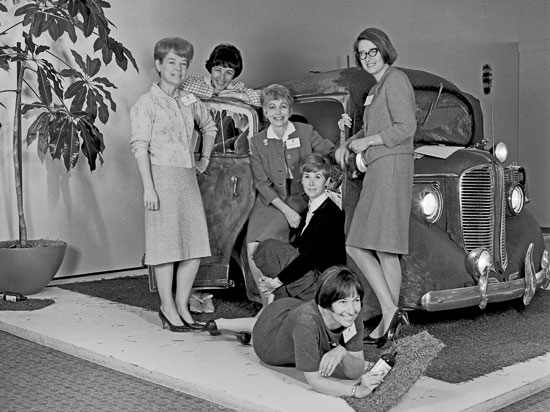
Terry Bell, second from left, and fellow docents defended Kienholz's "Back Seat Dodge '38" in LACMA's early years.
Terry Bell was a 34-year-old homemaker with two children in Westwood when art changed her life.
“It was the early ‘60s, and I had a good friend who did fundraising for the museum,” she remembers. “One day she said, ‘You’re a disgrace! You’re a college graduate and you don’t know anything about painting or sculpture.’ ”
At her friend’s insistence, she signed up for a then-new program to train docents at the Los Angeles Museum of History, Science and Art in Exposition Park, which at the time housed the county’s art collection. Now, 50 years later, she is an avid art collector, a Los Angeles County Museum of Art life trustee and a founding member of one of the largest docent organizations in the nation. She has exposed thousands of visitors to museum treasures, recorded acoustic guides for major exhibitions and worked against the censorship of controversial and important artworks.
And she traces it all to that decision a half-century ago to volunteer as a LACMA docent..
“It is just so rewarding,” says Bell, who this week is among the hundreds of honorees celebrating the golden anniversary of LACMA’s Docent Council. “Not only in terms of yourself, but in what you can give back to the community.”
Some 521 men and women belong to the Docent Council, a volunteer juggernaut whose members have led more than 2 million children and adults through the museum since it became an official entity in 1962.
More than a million Southern California schoolchildren have been led on field trips by LACMA docents; so have generations of adult visitors to the museum’s many exhibitions.
“We are definitely in the front lines,” says Judith Tuch, who chairs the council. “We provide the personal connection between the students and adults who come to the museum and the art they see. For many, it’s the first time they’ve ever been in a museum. For some, unfortunately, it may be the only time they’ll be in a museum.
“We encourage them to understand that this is a county museum, and that this is their place.”
The council grew from a small group of volunteers who explained art during the 1950s at what is now the Natural History Museum. Though visitors at that Exposition Park site mostly came to see dinosaurs and fossils, the county also had quietly been amassing fine art since the 1920s. Members of the Junior League, the Volunteer League of the San Fernando Valley and other local organizations offered informal tours of the gifts from such early donors as William Preston Harrison, Paul Rodman Mabury and William Randolph Hearst.
In 1961, amid planning for a separate Los Angeles County Museum of Art on Wilshire Boulevard, the groups joined forces to create a formal docent training program. Fifty-three women took the special classes in art history and elementary education.
After a provisional year, the Docent Council was officially formed, chaired by Glenn Cooper, a Junior Leaguer who later became a well-known arts patron in Sun Valley. Their goal: To train 200 docents in time for the official opening of LACMA in 1965.
The docents were key almost from the moment the new museum opened. In 1966, for instance, they rose to defend Edward Kienholz’s still-controversial “Back Seat Dodge ’38.” The piece, which depicts a beer-soaked encounter in a parked car, is so sexually charged that members of the then-Board of Supervisors denounced it as pornographic.
“I had met Ed Kienholz and talked to him about the exhibition, and I thought it was terrific,” Bell remembers.
 Eventually, the Supervisors decided the piece could be seen, “but the door to the car couldn’t be open unless a docent was there to explain it,” Bell says, recalling that at one point, she had to tour a group of clergy that included her own rabbi—whom she had to shush with the admonition that she listened to him every week, so he should do her the courtesy of returning the favor.
Eventually, the Supervisors decided the piece could be seen, “but the door to the car couldn’t be open unless a docent was there to explain it,” Bell says, recalling that at one point, she had to tour a group of clergy that included her own rabbi—whom she had to shush with the admonition that she listened to him every week, so he should do her the courtesy of returning the favor.
The piece—like later Kienholz exhibitions that Bell also guided—became a sensation and visitors mobbed the museum. “Five or six of us guided tours every 20 minutes,” Bell remembers, “almost around the clock.”
Since then, the council has grown along with the county in diversity and sophistication. Some 25 members are men and docents of all races, creeds, ages and backgrounds lead tours in multiple languages.
Now overseen by the museum’s Education Department, the group has a training regimen that includes extensive coursework in art history and touring techniques and a 2-year provisional period. No member can tour adults without spending at least 5 years doing school tours.
“We have several attorneys in the current [provisional] class,” says Patsy Palmer, a child psychotherapist and longtime LACMA volunteer who now trains incoming docents. “One man in my group is a retired doctor.” All the new docents, she says, “are highly qualified and uniquely skilled.”
“We’ve come so far,” agrees Bell, who says she can’t wait to see how visitors respond to “Levitated Mass” and other upcoming attractions. “We’re really in a marvelous place.”
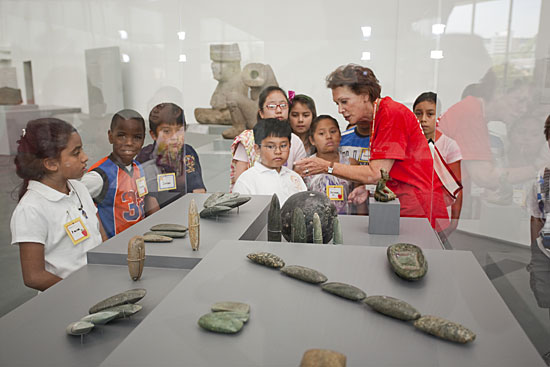
LACMA docent Patsy Palmer has shown the museum to legions of children. The Docent Council turns 50 this week.
Posted 5/2/12
Way to go, Hollywood Bowl
May 7, 2012
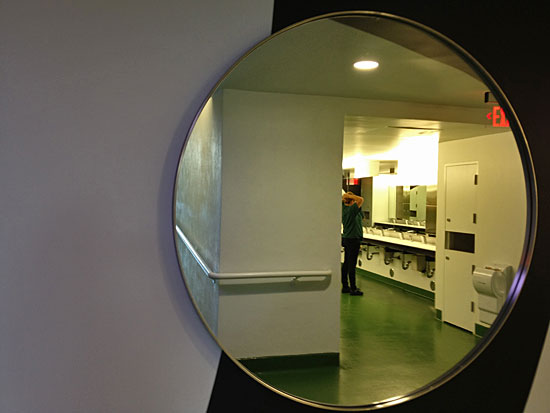
Glossy green floors, dramatic mirrors, Dyson hand dryers and LED lighting are all part of the re-do.
With legendary headliners ranging from Glen Campbell to Smokey Robinson to Plácido Domingo on the 2012 bill, it’s not easy for a newcomer to break through at the Hollywood Bowl.
But it’s a safe bet that the new restrooms designed by Rios Clementi Hale Studios will have audiences cheering when they make their Bowl debut this summer.
With sustainable features like Dyson hand dryers, LED lighting, water-saving fixtures, graphics inspired by the Bowl’s Art Deco architecture, and glossy green floors intended to bring the outdoors in, the restrooms represent a stark departure from the old, dark spaces that used to make intermission such a drab interlude.
[Updated 9/20/12: The Bowl’s bathroom re-do is a finalist in the America's Best Restroom contest sponsored by Cintas. Cast your vote here.]
The Bowl is a Los Angeles County park—albeit one with a worldwide reputation for glamour, fireworks and star-studded concerts—and the $3 million makeover was funded by Proposition A park improvement funds.
The bathrooms also feature reengineered layouts, dramatic mirrors, new privacy partitions between urinals and lighting accents to make sure patrons keep moving toward unoccupied facilities in the back, rather than creating unnecessary bottlenecks at the front of the line.
The new facilities were unveiled Monday evening at a Bowl reception along with some less noticeable but equally important off-season improvements like $600,000 in concrete repairs, including the replacement of a stairway built in 1954. Also underway, and expected to be finished in coming weeks, is the $2 million replacement of the moving sidewalk (also known as a speed ramp) that helps 75% of Bowl patrons get up the hill to their seats.
If you’d like to test drive the new and improved Bowl—and listen to some world-class music while you’re at it—tickets are on sale now. The season gets off to a big start June 22, with opening night festivities hosted by Julie Andrews and featuring Reba McIntyre, Chaka Khan and the Hollywood Bowl Orchestra conducted by Thomas Wilkins.
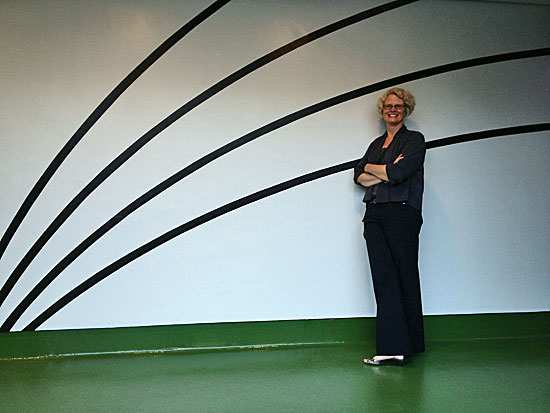
Julie Smith-Clementi of Rios Clementi Hale, outside one of the Bowl bathrooms redesigned by her firm.
Posted 5/7/12
Expo’s backstage safety patrol
April 27, 2012

With new Westside rail service, officials want to make sure that trains, cars and pedestrians safely co-exist.
Launch time for the Expo Line means crunch time for Vijay Khawani and Barbara Burns.
With the official opening this weekend of Expo’s first phase, Metro safety and education officials like Khawani and Burns have been working their way down a to-do list that, like the line itself, stretches from downtown to La Cienega.
And then there are the new things that keep cropping up.
Like the guy in the Maserati who ignored flashing signals and almost pulled out in front of an approaching train Tuesday.
Khawani, Metro’s Executive Officer of Corporate Safety, was out on the line with inspectors from the Public Utilities Commission when he spotted the car moving toward the tracks, so he raced down the station ramp toward it, waving his arms and yelling to get the motorist’s attention.
Crisis averted.
Making sure drivers, bicyclists and pedestrians stay alert around the trains—especially while they’re still something of a novelty—is a major preoccupation as Expo gets ready to roll.
Khawani and Burns, manager of Metro’s Transit Safety Education Programs, are key players on a team that must not only ensure that Expo meets all the regulatory requirements but also presents a safe and familiar image to the public in the line’s crucial early days and weeks.
For months, Burns has been deploying a small army of “safety ambassadors”—24 retired bus and rail operators—into communities around the new line to help people navigate the new system and to report back on trouble spots.
“We start one year before any train takes the track,” she said. “In the beginning, it’s always chaotic.”
To educate the public about what’s headed their way, Burns’ team has conducted dozens of training sessions at schools, senior centers and libraries and with neighborhood watch and community groups, sent out hundreds of notices about train testing, put up 4,000 safety posters and handed out 60,000 flyers door to door.
They’ve also placed safety ads on the sides of 20 trains—with bilingual messages such as “Hear bells? See lights? Train’s coming.”
“We started to do it with the Eastside Extension (of the Gold Line) and found it to be very effective,” she said. “It’s like a moving billboard.”
Still, some people don’t get the message. There have been three collisions involving Expo Line trains since testing began—all the result of motorists proceeding against a flashing red light signaling an approaching train, Khawani said. The most recent accident, on April 19, was caused by a driver making an illegal left turn, he said.
“That type of accident is actually the most common type of light rail accident in the industry across the country,” he said. “I think education is a big component because this is something that’s new in the neighborhood. They’ve never had trains.”
Common sense goes a long way, he said. There have been no serious injuries in the Expo crashes, but a brand new Mercedes Benz was totaled on March 19 when its owner got distracted “playing around with the new navigation system,” he said.
“We can’t do it alone,” Khawani said. “They’ve got to obey the signs.”
Large crowds are expected to ride Expo for free on its inaugural weekend, Saturday and Sunday, April 28 and 29. And before the light rail makes its public bow, a series of technical and mechanical fixes have been required.
An automatic routing system to make sure Expo and Blue Line trains—which share some stations in downtown L.A.—get on their respective tracks logged 20 “misroutes” on a recent day of testing.
So at least at the beginning, controllers in Metro’s Rail Control Center (known as “The ROC”) will be routing the trains manually.
“It’s a temporary fix until we can assure ourselves that the automatic routing function is working reliably. It’s not a safety concern, it’s more an operational concern,” Khawani said. “When you’re on a train for Long Beach, you don’t want to end up in Culver City”—an unlikely scenario, he added, because the train operator would almost certainly notice the misroute before reaching the end of the line.
Another major priority is making sure that trains don’t block intersections. That has meant getting the city Department of Transportation to change signal timing to give train operators some extra “green time” to proceed through intersections—first 10 extra seconds and then, as of Sunday, 4 more.
“Four seconds make a big difference,” Khawani said. “Since Sunday, we have not seen any trains blocking any intersections. It has improved it dramatically.”
A test run Tuesday with the PUC inspectors onboard was largely successful, although two signs at the Crenshaw station needed to be relocated so trains can proceed without getting stopped between stations.
At the La Cienega station, Khawani checked to see that emergency lighting required by the L.A. Fire Department was in place and working. (It was, and he snapped a photo with his phone.)
No detail, it seems, is beneath his attention. He called in a mistake he spotted at the Western station, where a pavement sign reading “Stay Behind Yellow Line” was accidentally transposed to read “Yellow Line Stay Behind.”
Animated but apparently unflappable, Khawani has seen 20 years’ worth of launches since he joined Metro. And he says he has never doubted that the Expo Line would open Saturday.
“This is very typical of all openings,” he said. Still, don’t expect him to let his guard down anytime soon. “I don’t think there is ever a time when you get to breathe a sigh of relief.”
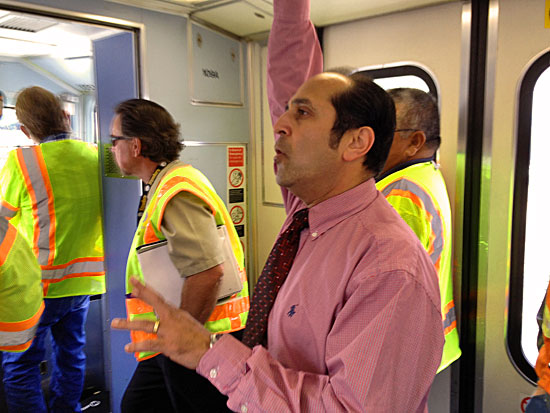
Vijay Khawani, Metro’s Executive Officer of Corporate Safety, rides Expo with safety team and PUC inspectors.
Posted 4/26/12
Getting there is all the fun
April 25, 2012
When the first segment of the Expo Line opens Saturday, it will whisk transit patrons to destinations like the Coliseum and the Los Angeles County Natural History Museum. On opening day, riders won’t even need to leave the station platforms for a good time.
Celebrations with live entertainment will be held Saturday, April 28, at four stations—7th/Metro, Expo/USC, Expo/Crenshaw and La Cienega/Jefferson. There will be standard fare including live music, info booths and L.A.’s ubiquitous gourmet food trucks, but there are also a few off-the-beaten-path diversions.
For starters, how about a psychic magician with a cat assistant? The Fantastic Fig and his cat, Newton, have appeared on America’s Got Talent and the Kathy Griffin Show to perform their mind-bending card tricks. On Saturday, the crowds at La Cienega/Jefferson station will get a close look at what the Fig has up his sleeve as he performs a roving routine.
If magic’s not your bag, a professional mime will also be riding the rails, performing on trains and in stations. Artist Tony Duran of the 24th Street Theatre gives silent performances that range from purely comedic to serious and dramatic. Unfortunately, despite multiple attempts, the mime could not be reached for comment.
Alternatively, the inaugural crowds can show off their own abilities via karaoke, which takes place at Expo/Crenshaw and La Cienega/Jefferson stations. The less vocally-inclined might opt instead to memorialize the occasion in photos, using Cirque du Soleil’s “green screen” to transform themselves digitally into virtual Cirque performers, at the 7th/Metro station. In addition, photo booths will be arranged at other stations so patrons can personalize snapshots with props and possibly a map of the new light rail line as a backdrop. Photos will be posted online after the event.
In addition to the sideshows there is, of course, the main event. This weekend, the shiny new Expo Line is the belle of the ball. Free rides will be offered Saturday and Sunday, from 5 a.m. to 7 p.m. After that, the line starts taking on paying customers and will operate from 5 a.m. to midnight.
(During the inaugural run, trains will be bypassing the line’s Farmdale and Culver City stations, which are not yet completed, though they are expected to open in the weeks ahead.)
According to Anna Chen of Metro’s media relations department, the opening day fun is all about the communities Expo will serve.
“We tried to incorporate local talent and promote the businesses and vendors along the line as much as possible,” said Chen. (A look at some of the eateries and other attractions along the line is here.)
Expo is expected to be one of the nation’s most heavily-used light rail lines. A second phase to Santa Monica is now underway.
Posted 4/25/12




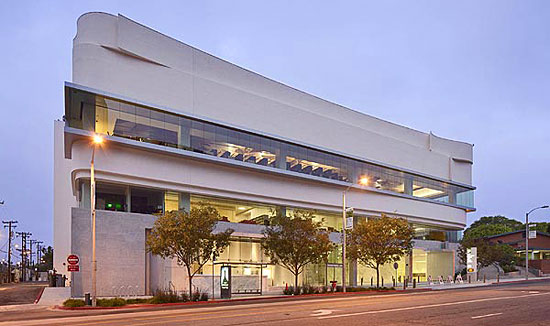

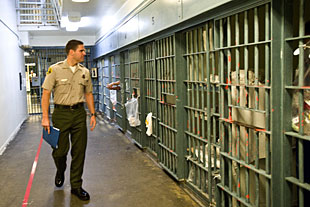


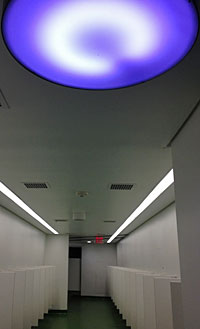








 405 bridge work causes a stink
405 bridge work causes a stink

